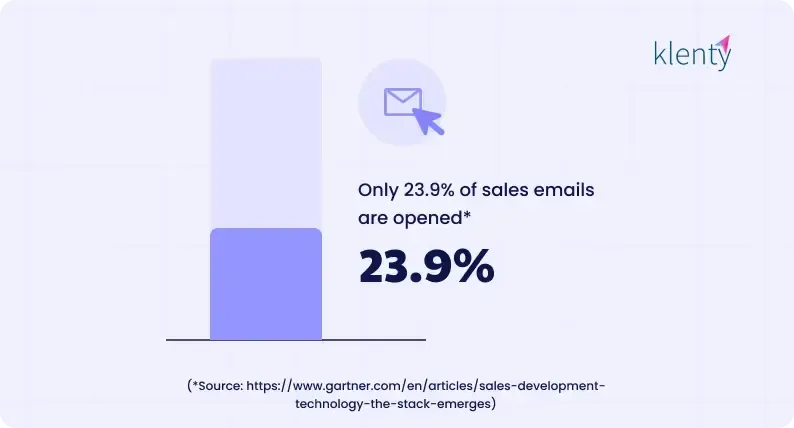Do you spend half your day crafting irresistible cold emails and the other half pulling your hair out in frustration because nobody bothers to open them?
We get it. Nobody likes being snubbed. More so when you’ve spent precious time researching your prospect’s background and putting together just the right set of words you think will “click.” If your prospect decides opening your email is not worth their time, where does that leave your marketing results?
That’s not to say you should throw in the towel on cold emailing, for it is still one of the best ways to reach your potential customers.
It’s not your fault that the average prospect is staring at a flood of cold emails each day. Getting them to notice you is a game of wits.
Here we discuss what the average cold email open rate is, how you can measure your cold email success, and how to improve your open rates.
What Is the Average Cold Email Open Rate?
The average cold email open rate, according to studies, ranges between 20 and 40%. Our recommendation is that it largely depends on how big your prospect list is. Say, you have above 1000 prospects in your email sequences, except the lower end of the open rate, like 20-30%. If it's a smaller list of highly targeted prospects of 150-300, expect to get higher open rates of 40% and above.
a) Gartner's 2019 study found that the average cold email open rate was 23.9%.

b) But Quickmail reports suggest that the number is closer to 44%.
Grain of salt to take: All the research out there is done based on different parameters like the number of cold emails sent, the industry they’re in, how relevant the subject line was to the prospect, etc. So, the open rate can vary depending on what your use case looks like.
i) What Is a Good Open Rate for a Cold Email?
Anything north of 20% cold email open rate for a larger prospect base (say 1000 and above), and 40% cold email open rate for a smaller and more targeted prospect base are good numbers. Many have even witnessed open rates much higher than the average from time to time. If you have a prospect list that's really close to your ICP, and have nailed your prospect's pain points in the subject line, you'll get great open rates.
Truth is, the best open rate for your cold email campaign depends. On your audience, industry, and target demographic. For example, if you’re in a niche industry like demo automation and are targeting a tight list of businesses that are practicing product-led growth, expect higher open rates.
That said, an open rate of over 50% is excellent, no matter your niche, especially in the B2B space.
ii) How To Calculate Cold Email Open Rates?
Most cold email tools will show you the open rate for your campaign instantly. Doing your cold email outreach manually? Here are two formulas to crunch those numbers.
Formula 1
Open rate = (Total unique opens/Total recipients) * 100
Unique opens = number of addresses in your email list
Total opens = number of recipients that open your emails

Say, you send 4540 cold emails. Of these, you get 1104 unique opens.
Open rate = (1104/4540)*100 = 24.3%
Formula 2
While the first method does the trick well enough, you can look to a slightly more advanced formula, taking into account another variable—bounce rates or # of bounced emails.
Open rate = (Total unique opens/ (Total recipients-Bounced emails) * 100
Unique opens = number of email addresses in your email list
Total opens = number of recipients that open your emails
Bounced emails = number of emails sent that never landed in the recipient’s inbox
Let’s go back to our earlier example–say you have ten bounce-backs.
Plug the numbers into the formula, and et voila!
Open rate = (1104/4530)*100 = 24.4%
This formula gives you an even more accurate reading of your cold emailing efforts, given it accounts for email deliverability.
How To Improve Cold Email Open Rates
First impressions always matter. One wrong move, and you risk landing in the trash or, worse, the spam folder. So, optimize your email address, subject line, timing, and the like, before sending that first email.
Not sure where to begin? Here are five best practices to help you out.
i) Use a Professional Email Address
If your email address looks something like this- ‘[email protected]’, your recipient might assume a cat is corresponding with them. Cute, but not open-worthy.
A cold email from a professional ID reads as credible.
Now, info@companyname or contact@companyname sound robotic, missing that good old human touch. These are dead giveaways of a mass cold outreach campaign. This will affect your open rates and, therefore, your reply rates.
Make it '[email protected]', and it works much better. For one, it gives your prospects a glimpse of the person behind the email, encouraging them to ‘click.’
ii) Personalize Your Subject Line
Not only do 71% of consumers expect personalized interactions, 76% even get frustrated when that doesn’t happen.
In the day and age when even coffee cups are personalized, generic cold emails will not have any impact. Our research finds that emails with personalized subject lines have a 20% higher average open rate.
Based on our in-house research, the best 4 ways to personalize are:
- Use the recipient’s name. Our study shows that doing this alone can give you a 26.74% open rate higher than impersonal subject lines. For example:
Hey (prospect’s name), are you facing (issue)!
Check this out (prospect’s name), our new product just launched
- Alternatively, use your prospect’s company’s name. Our research shows that sales reps have witnessed a 20% higher open rate with this approach. Examples of how you can include this in your email copy’s subject line are:
The best software partner for (company name) just landed! or
It’s time to get (company name) the stage it deserves!
- Invoke their pain points in the email subject line. Our research shows that such personalized cold emails see an 11.33% higher open rate. So, what do subject lines with pain points look like? Some examples:
Is your revenue projection for Q3 suffering? or
Reduce operation costs by 20% with our new launch
- Use the prospect's personal information (from their LinkedIn). Reference it gently in your email subject line. Top-performing SDRs use this technique routinely to get prospects to open their emails. A word of caution: don't hyper-personalize every email. Almabase's top-performing Enterprise SDR, Joel, warns that such hyper-personalization, especially when doing large-scale outreach, can take up considerable time. “You have to be mindful about where you spend your time too. So, it’s always a balance. If you feel like there’s something really relevant in their profile that you can personalize for, you can actually use that,” he adds.
iii) Edit the Preview Text
The first thing your prospect looks at when a new email lands in their inbox is the subject line. The second thing? The email preview text. Naturally, they're an important contributor to those open rates.
Now most email clients automatically pick up preview text from email content. Depending on the client, that's often the first few lines of your email or the alt text from the linked images. The good news is that you can edit this preview text using cold email tools and amp up open rates.
Our advice:
- Add context to the email subject with the preview text. For example:
Email subject: Increase your conversion rate by 20%, [prospect name]
Preview text: Make your pipeline leak-proof with [product name].
iv) Optimize Your Subject Line Length
A 2021 Litmus survey revealed that 41.6% of email opens occurred on mobile devices. Here’s another interesting fact. Most mobile devices (despite their large dimensions) can display a maximum of 60 characters at a time. That’s about seven words on average.
So, if you’re burying the important bits of your catchy subject ahead of the first 60 characters, chances are, they’re going unnoticed by a majority of your prospects–straight to the trash.
Shaking your head at the seven-word limit already? One-word subject lines might have you grabbing a glass of water. Light Stalking conducted A/B testing wherein they shared emails with one-word subject lines. The result? An 83% jump in website traffic. This case study is a great example of less is more when it comes to subject lines.
So, how long should your subject length be, if not seven whole words? Well, like all good things in life, it depends.
Your target audience may have different preferences for subject line length depending on the demographic or your niche. The best way to arrive at an optimal subject line length is through A/B testing.
v) Time Your Email Carefully
Don't let your cold emails become a rom-com with lousy timing. Instead, send them to the right person at just the right time to create magic (we mean more email opens, of course).
Research shows that Fridays are the best day to send effective cold emails. In those 24 hours, the 3 pm to 5 pm window is your best bet.
Our theory? You could say your prospects are in a better mood with the weekend approaching. They're gearing up for a break but want to leave their inbox sorted for Monday morning. So, you can expect your sales email to get attention during these golden hours.
Pro tip: If you have different time zones with your prospects, consider that when scheduling your emails.
vi) Answer Their WIIFM (What’s in It For Me) In the Subject Line
Don't wait around to get to the point. We're all bored with those hopeless 'hope this email finds you well' platitudes.
In fact, you need to show them what lies ahead even before they open your email. Answer the what's-in-it-for-me question right in the subject line so the matters stick with you until the very end. A concise subject line showing the reader what's in it initially is nothing new. Remember Barbies? You could touch their hair or shoes right through the plastic packaging. Giving us a little bit of playtime to get us hooked. Use the same strategy.
Here are some examples.
- Solution to plunging blog traffic
- Struggling to scale your cold email outreach?
- Reps struggling to hit quota?
Answering the question in the reader’s mind straight away makes your email look less like a sales gimmick and more like the real deal.
vii) Don’t Forget To Follow Up
Let's be honest. Most prospects will ignore your emails in cold blood. Is that your fault? Yes, and no.
Most people don't respond to the first cold email; people may open your cold email only the 3rd or 4th time. On average, you must send up to 4-6 follow-up emails to get your prospect's attention. This, along with different call-to-actions in different emails, could improve your open rates, and response rates.
The Takeaway
Improving your cold email open rate is no longer about trial and error. Through tons of research and examples, we know just which elements work in getting your cold emails opened. And implementing the above tips can bump up those cold email open rates even further.
That said, remember what gets your prospects to peek at your email body might differ based on your niche and your prospect’s stage in the buyer journey. So, A/B test different subject line approaches like:
- using short subject lines,
- posing questions in subject lines,
- going for to-the-point subject lines
- focusing on prospects' pain points
- personalized to the prospect's interests
to land on a strategy that drives your email opens.
May the cold email force be with you.
FAQs
What is the cold email open rate benchmark?
Is a 40% open rate considered a good metric?
Resources You'll Love
- The Average Cold Email Response Rate in 2023 (+ Expert Tips To Improve It)
- How To Write a Cold Email That Boosts Responses
- 120+ Cold Email Templates That Will Surely Get Responses
- 21 Best Email Sequence Software for 2023 (Features+Pricing)
- 6 Klenty Features You Can Use to Boost Your Email Deliverability

